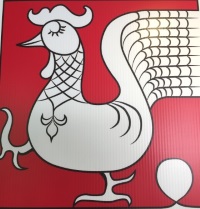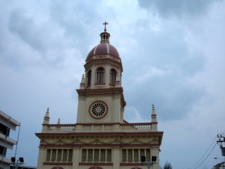- Home
- Bangkok Shrines
- Kuan Yin Shrine
Kuan Yin Shrine
Goddess of Mercy on the
Chao Phraya
By Eric Lim
The Kuan Yin Shrine in
Bangkok is in an old Chinese building within a community on the Chao
Phraya River where time seems to have stood still for the last 200
years.
The site originally had two shrines built in the reign of King Taksin (1767 – 1782) by his Chinese supporters. The dilapidated buildings were torn down in the reign of King Rama III (1824 – 1851) and rebuilt to house Kuan Yin, the goddess of mercy.
Today, the Kuan Yin Shrine is in the care of a local Chinese family living in the area. In Thai, the goddess of mercy is known as Jao Mae Kuan Im.
Kuan Yin, an ancient Chinese goddess, embodies the virtues of love, kindness, compassion and forgiveness, a legend that goes back almost 3,000 years.
She was Miao Shan youngest daughter of a Chinese king, who was blessed with virtue and spurned her corrupted father’s greed for wealth and power. When she rejected his order for an arranged marriage, he drove her out of their home.
Rejected,
persecuted and exiled by her father, she dedicated her remaining years
as a nun healing the sick and destitute and as a savior of shipwrecked
sailors.
When her father was mortally ill, a monk advised him that this only cure was a medicine made from the arms and eyes of one pure in heart and free from anger.
Miao Shan heard of this and sacrificed her eyes and arms for the potion to save her father.
After the king was cured he sought out his benefactor in the mountain only to discover she was his daughter whom he had mistreated.
He prostrated himself before her and begged for her mercy and forgiveness. As an act of atonement he ordered a monument for her.
Her selflessness earned her eternal worship and the Kuan Yin Shrine became a Chinese cultural heritage.
The early Chinese immigrants to Bangkok continued the tradition and built a shrine for the Goddess of Mercy on the Chao Phraya River near where they lived.
Some versions of Kuan Yin, depict her with a thousand hands with an eye in each palm; a thousand hands to help those in need and a thousand eyes to see who are in need for one who has made the supreme sacrifice and attained enlightenment through compassion and mercy.
To get there, please see the Kuan Yin Shrine map below
An elevated walkway, a recent addition, runs from the pier along the riverbanks and a small footbridge with a red arch links the walkway to the main gate of the shrine.
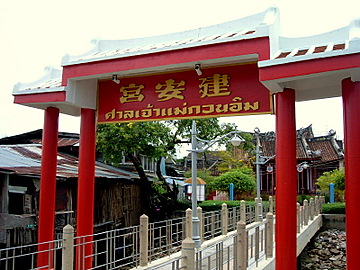
The gateway to the shrine
At the end of a small red-tiled courtyard is the period Chinese structure housing the Goddness of Mercy.
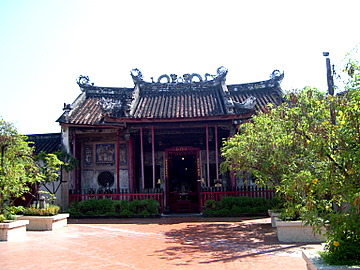
The quiet courtyard and the main building
There’s no one in sight. It’s almost like a scene from a historical Chinese movie. I half expected to be confronted by black-clad masked sword men leaping over the wall into the courtyard.
Two fiery dragons ride the crest of the roof, glaring down fiercely. The wooden doors in the sidewalls leading to the inner quarters behind are closed.
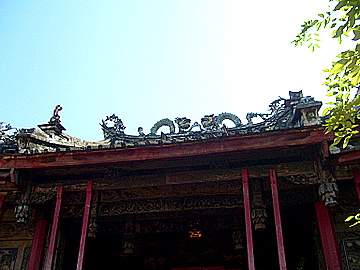
Chinese dragons on the roof
Images of classical Chinese characters are engraved on the front walls on both sides of the door.
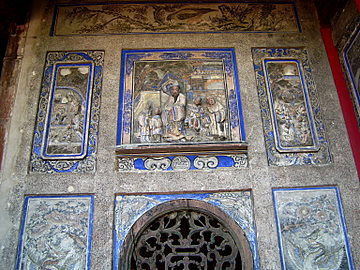
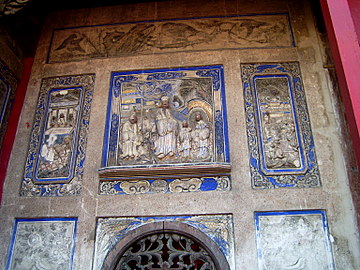
Above the opened main door, are elaborately carved lintels.
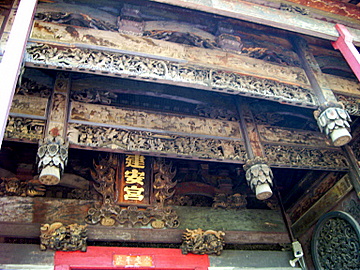
Lintels
No photographs are allowed inside the shrine. So will have to be the last shot.
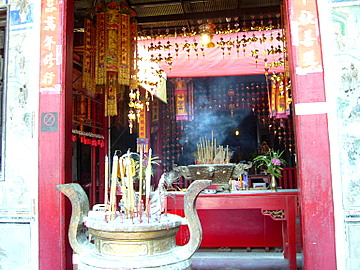
Door to the building housing the shrine
Inside the shrine, painted walls of Chinese warriors and old red Chinese lanterns hanging from the rafters create a mood reminiscent of ancient China, a mood seemingly unchanged over the years in the Kuan Yin Shrine.
A smaller altar with several Kuan Yin statues stands in the open yard in the center of the shrine. In the main altar, in the covered area to the rear, a metre-high gold statue of Kuan Yin, the goddess of mercy, sits serenely facing the Chao Phraya River.
It’s not a busy shrine on non-festive days. The occasional worshipper comes in to pray and pay respects as the day goes lazily by. Life on the river is quiet except for a few children playing by the pier and the odd fisherman.
Meanwhile, in the Kuan Yin Shrine, the goddess of mercy, gazes benignly at the bustling river beyond as the riverboats go streaming by.
"Father, I have suffered no pain. Having given up these human eyes, I shall see with diamond eyes. Having yielded the mortal arms, I shall receive golden arms. If my calling is true all this will follow."
Map to the Kuan Yin Shrine
View Kuan Yin Shrine map in a larger map
How to get there
The easiest way to get there is to take the MRT Blue Line to BL32 Itsaraphab. From there take a taxi to the shrine.
While you are there visit Wat Kalayanamit as well as the old Santa Cruz Church.
To return to Bangkok Shrines.
Related page
Other attractions nearby
Tour Bangkok Legacies – my first e-book
If you are an independent traveller, here's a handy e-guide book, Tour Bangkok Legacies, which will help you along as you explore the streets of Bangkok and discover its old treasures. It's complete with historical descriptions, maps and detailed directions on how to get to these places.
My Kindle edition

Search Tour Bangkok Legacies with DuckDuckGo
Related page
My Journey through Thailand
Part I The First Steps
My Kindle edition

My Smashwords edition

